- Submissions

Full Text
Advances in Complementary & Alternative medicine
Occless Essix: A Modified Essix Retainer
Himali Gupta*, Kuldeep Dmello, Pooja Sharma, Shalini Singh
Department of Orthodontics, India
*Corresponding author: Himali Gupta, BDS, MDS, Post Graduate Student, Mathura, Uttar Pradesh, India
Submission: May 17, 2018;Published: December 20, 2018

ISSN: 2637-7802 Volume3 Issue3
Abstract
Objective: To evaluate the efficacy of retention and stability with a modified Essix retainer without occlusal coverage.
Materials and Methods: 20 Adolescent patients undergoing fixed appliance treatment at the department of Orthodontics of KD Dental College, were recruited for this study. 10 patients (5 women and 5 men) wore Essix retainers (Group I) while 10 (5 women and 5 men) wore modified Essix retainers (Group II) and the mean follow-up recall time for both groups was 6 months. Two qualified dental examiners evaluated the blind patient data. Lateral cephalograms were analyzed at 2 stages: Post-treatment (T0) and follow-up (T1). Means and standard deviations were next compared between the retention and stability of both appliances. Results: Cephalometric measurements revealed minimal differences between the 2 groups, such as slightly higher protrusion of the upper incisors in the Essix group during orthodontic treatment, which was statistically non-significant.
Conclusion: The retention characteristics of both the retainers are similar. However, Occless Essix gives better vertical stability since the initiation of post-treatment phase.
Keywords: Essix; Retention; Relapse; Modification of essix
Introduction
The retention phase is vitally important in keeping teeth in a debonding position until gingival and periodontal reorganization is completed [1]. To date, several studies have been published about the effectiveness, retention protocols, occlusal contacts, survival time, and wear of retainers. However, it could be difficult to interpret the results and evidence presented in these studies because of the variety of study designs, sample sizes, and research methods. A clear retainer (Essix® retainer, thermoplastic retainer, or vacuum‑formed retainer) is a removable retainer that was introduced in 1993 by Sheridan et al. [2] as an esthetic, comfortable, and inexpensive appliance compared with conventional fixed and removable orthodontic retainers [3].
After teeth have been orthodontically re-positioned, retention devices are used to maintain arch form and minimize the tendency of teeth to shift [4]. When teeth do shift, changes that are undesirable are considered “relapse,” while changes that are desirable are called “settling.” With settling, the number of occlusal contacts (once the fixed appliances are removed) increases, improving the fit of the teeth. The best retention device would be one that allows settling but prevents relapse [5]. Both removable and fixed retainers can be used to provide retention. This study aims to compare conventional Essix retainer with Occless Essix (Modified Essix Retainer) and discuss the fabrication, advantages and disadvantages of this clinical innovation.
Materials and Methods
20 Adolescent patients undergoing fixed appliance treatment in the department of Orthodontics, KD Dental College were recruited for this study. 10 patients (5 women and 5 men) were given Essix retainers (Group I) and 10 (5 women and 5 men) were given modified Essix retainers (Group II) to wear and the mean followup recall time for both groups was 6 months. Two qualified dental examiners evaluated the blind patient data [6].
Figure 1:Conventional essix.
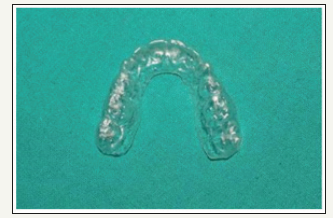
Group I-Ten patients were given conventional Essix Retainers to serve as a control (Figure 1) Group II-Ten patients were given modified Essix Retainers free of any occlusal coverage (Figure 2). The procedure and aim of the study was explained to the patients and their due consent was obtained. This study has been done in human interest and no human was harmed during experimentation [7].
Figure 2:Occless essix.
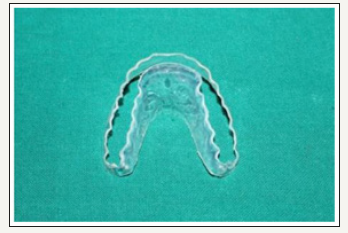
Lateral cephalograms were analyzed at 2 stages of both the groups: At beginning of retention phase (T0) and 6 months after the retention phase (T1). These retainers were fabricated with thermoformed sheet (Clear-Aligner CA-hard) of 1.5mm thickness with Bio Star Machine. The retainers were delivered to the patients and instructions were given as follows:
A. OE retainer has to be worn all the time except during meals.
B. It should be kept safe and do not misplace it (as it is clear retainer so tendency of misplacing it has been reported quite often).
C. If the retainer is fractured, immediately report to the clinician.
As the study is dependent on patient compliance, they were recalled for regular checkup at a period of 1 month. Means and standard deviations were next compared between the retention and stability of both appliances. The potential movements of incisors and vertical skeletal changes were evaluated on the lateral cephalograms. Lateral cephalograms were obtained using the radiographic equipment with focus median plane distance was 152cm with standardized exposure of 73kV, 15mA for 0.64s, and the radiographic film used was Kodak MXG (18×24cm2; Kodak, Tokyo, Japan). A sheet of transparent acetate was placed over the lateral cephalometric radiographs, and the anatomical structures were outlined. Overjet, overbite, and the following angular measurements-GoGnSN°, FMA°, U1SN°, IMPA°, and UL-L1°-were performed on these radiographs.
Fabrication
a. Immediately after the removal of the fixed appliances, alginate impressions were poured to obtain models of the maxillary and mandibular arches.
b. After obtaining a dental cast, interproximal areas and gingival borders should be distinct and excessive undercut should be blocked out with compound filling to enable the patient to remove it more easily.
Figure 3:(A) Marking at Incisal 1/3rd of the tooth (B) Trimming of occlusal surface with the help of acrylic bur (C) Trimmed Occless Essix retainer occlusal view (D) Trimmed Occless Essix retainer lateral view.
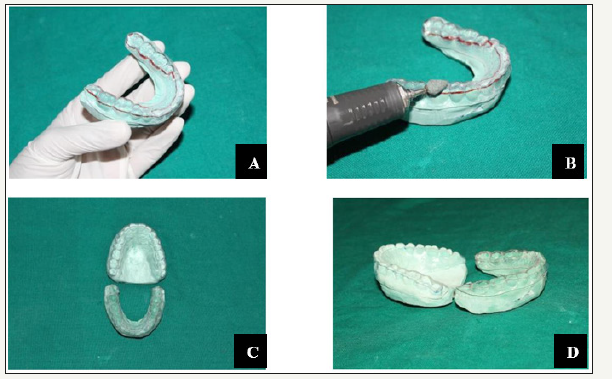
c. Essix retainers were thermoformed from 1.5mm sheets according to the manufacturer’s instructions. Occless Essix (OE) retainers were thermoformed from 1.5mm sheets and occlusal one third was trimmed after marking (so as not to over trim). The border of the appliance should extend gingivally 3-4mm on both facial and lingual sides. The gingival edge should be notched in the area of labial and lingual frenums (Figure 3).
d. The patients were instructed to wear their retainers fulltime (except during meals) for a period of 1 year.
Data Analysis
The differences between the Essix and Occless Essix groups were compared using repeated measures analysis of variance (ANOVA) to identify statistically significant differences between time intervals. Changes between T0 and T1 time points within the same group were analyzed. Changes between the 2 groups were compared using the Mann-Whitney U-test. SPSS (version 14.0; SPSS Inc., Chicago, IL, USA) was used to perform statistical analysis. p-values of < 0.05 were considered statistically significant [8].
Result
Table 1 present the means and standard deviations of treatment changes and the degree of relapse at the post-treatment and postretention stages. Cephalometric measurements revealed minimal differences between the 2 groups, such as slightly higher protrusion of the upper incisors in the Essix group during orthodontic treatment (Table 1) which was statistically non-significant.
Table 1:Cephalometric measurements at bracket removal and after 6 months of retention (T0 and T1 respectively).
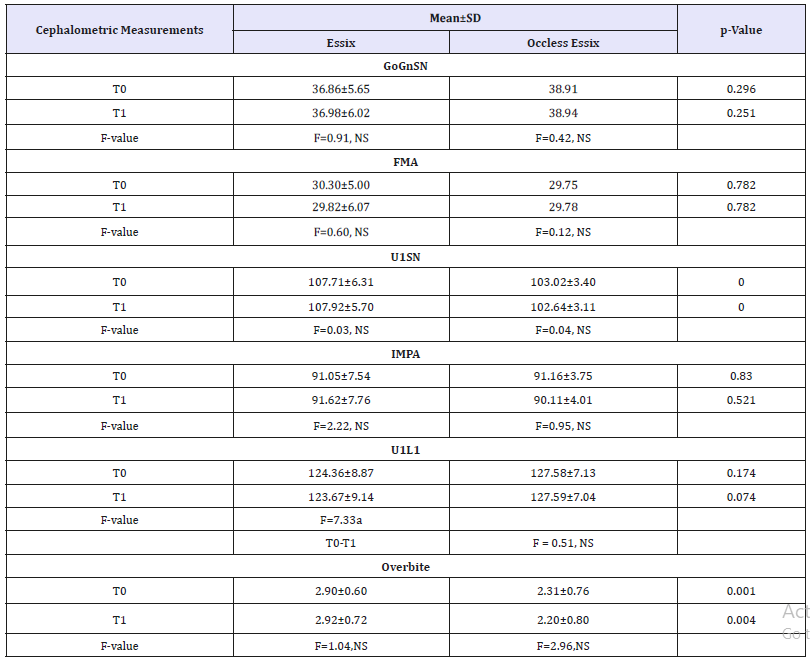
Discussion
In any orthodontic treatment, retention following removal of fixed appliances is of paramount importance. After orthodontic treatment, an ideal retainer would be retentive, capable of achieving three-dimensional control of all teeth, able to maintain the posttreatment arch form, and allow occlusal settling [9]. According to Case [10] the art of retention will never be as accurate as the science of tooth correction, having little or no control regarding natural influences on teeth. The main factors related to failure of orthodontic retention are: Hereditary influences; Disrespect to biological limits of dental movement and the use of an inappropriate retention system among other [11].
A dental retainer is a custom- made orthodontic appliance used to keep teeth in place after fixed appliance are removed. Starting from Hawleys appliance given by Charles Hawley in 1920 till date, there has been many forms of retainers given to the patient for better patient’s compliance and stability of teeth. Retainers can be removable like wraparound, tooth positioners or clear overlays or they could be fixed like bonded retainers.
Presently the most commonly used retainers are Essix retainers or the clear retainers. It was first described in 1971 by Ponitz, and consists of a thermoplastic polymer, heated in a vacuum inclusor in such a way that it suits the model of the arch which will be retained. Many studies were carried to compare the efficacy of Essix and Hawley retainers. One such study was done by Lindauer & Shoff [3]. They modified the design of the Essix retainer and covered only canines and incisors that might cause posterior extrusion and anterior open bite. In their study, the researchers focused on overbite, overjet, and irregularity index and compared the changes over a 6-month retention period; they found no significant differences between the 2 retainers.
To overcome the disadvantages of Essix retainers like nonsettling of occlusion, TMJ dysfunction, posterior open bite and improper occlusal contacts, the modification in this study was done to remove the occlusal coverage throughout the appliance. This modification eliminated all the disadvantages of Essix retainer and inculcated immediate vertical settling of occlusion post debonding of fixed appliance. The time of wear was maintained as other retainers. Increase in posterior contacts was achieved during night time wear of modified Essix retainer where posterior occlusal contact was impassive [12].
As noted by Reitan & Kvam [13] in his study, the periodontal fibers remained with memory until 7 months after removal of fixed appliances, which would force the use of appliances, both in the upper and lower arches for 7 months at a minimum for the retention of the fixed orthodontic treatment. Although there is no universal agreement concerning retention protocols for removable appliances, many authors have advised that these appliances should be worn for at least 1 year after orthodontic treatment [14]. There is not a known usage time for using retention, it is only known that at least 232 days are necessary for periodontal fibers to reorganize into the new position [15]. There is no agreement in the literature concerning the duration of the retention period. Some authors defend periods of two to three weeks, even occurring indication of permanent retention [16].
Sauget et al. [5] study compared the Hawley appliance and acetate appliance covering all elements. The Hawley retainer showed larger number of contact points, which supports our modification of Essix retainer and hence we coined the name Occless Essix retainer.
According to the cephalometric analysis (Table 1), the major differences were seen in U1SN°, U1L1°, and overbite measurements. The U1SN° was slightly reduced in both groups but upper incisor protrusion was high in Essix group. The IMPA° was insignificantly increased in the Essix group but reduced in the OE group which was similar to a study done by Little et al. [17] indicating no significant correlation between the long-term stability of the mandibular anterior teeth and any of the cephalometric measurements.
Conclusion
This study revealed that the retention characteristics of both Essix and OE retainers are similar. The Occless Essix retainers were found to be more effective in maintaining the occlusal contacts during retention and the patients did not face any initial discomfort or improper bite. Clinicians and patients should be aware of the relapse potential of malocclusions, especially crowding. Other factors such as cost, patient preference, cooperation, satisfaction, and occlusal contact patterns might influence the choice of retainer. Further clinical studies with larger randomized samples are necessary to investigate the long term efficacy of the Occless Essix retainer.
Advantages of OE over Essix:
1. Good retention and stability of teeth.
2. Good retention and stability of the appliance
3. Helps in vertical correction (settling) full time during appliance wear as no occlusal coverage is present and large number of contact points occur benefiting the occlusion of patient [5].
4. Helps in proper occlusion immediately after debonding of fixed appliance.
5. No Temporomandibular joint dysfunction (TMD) which can be seen in conventional Essix due to increase in bite [6].
6. More esthetic and less visible as in conventional Essix, a black outline is always seen varying according to the thickness of Essix sheet is always visible.
7. Inexpensive.
8. Ease of fabrication.
9. More comfortable to the patient.
10. Ability to place on the day the fixed appliance is debonded.
11. Good survival time than Essix as does not wear and tear due to occlusal free surface.
12. Provides better oral hygiene than fixed retainer [7].
Disadvantages of Essix over OE:
1. Anterior open bite in patients wearing Essix retainers, probably because of the posterior disclusion caused by the anterior contact of the Essix material [3].
2. Nonsettling of occlusion due to occlusal surface coverage of Essix [8].
3. Temporomandibular Dysfunction can be seen due to disturbance in occlusion[bite][6].
4. Prone to wear and needs replacement.
5. Fracture seen was more in Essix than in OE as Essix is more rigid appliance.
6. Easily lost due to transparency [9] (Figure 4 & 5).
Figure 4:The Occless Essix in mouth.
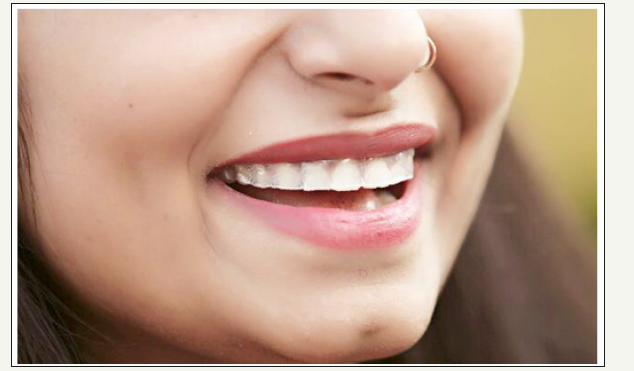
Figure 5:Patient holding and wearing the Occless Essix.

Acknowledgment
I dedicate this work to my mentors Dr. Kuldeep and Dr. Pooja. Kuldeep sir has always steered me to never back off from whatever hardships comes and Pooja maam has always helped me put words to my work in right time and right place. Shalini has always been by my side in my ups down and this has kept me going.
References
- Melrose C, Millett DT (1998) Toward a perspective on orthodontic retention? Am J Orthod Dentofacial Orthop 113(5): 507‑514.
- Sheridan JJ, LeDoux W, McMinn R (1993) Essix retainers: Fabrication and supervision for permanent retention. J Clin Orthod 27(1): 37‑45.
- Lindauer SJ, Shoff RC (1998) Comparison of Essix and hawley retainers. J Clin Orthod 32: 95‑97.
- Joondeph DR, Riedel RA (1994) Retention and relapse. In: Graber TM, Vanarsdall (Eds.), Orthodontics-Current principles and techniques. Mosby Year Book, St. Louise, USA, pp. 908-950.
- Sauget E, Covell DA, Boero RP, Lieber WS (1997) Comparison of occlusal contacts with use of Hawley and clear overlay retainers. Angle Orthod 67(3): 223-230.
- Cawson RA, Odell EW, Porter S (2002) Cawsonś essentials of oral pathology and oral medicine (7th edn). Churchill Livingstone, UK.
- Heier EE, De Smit AA, Wijgaerts IA, Adriaens PA (1997) Periodontal implications of bonded versus removable retainers. Am J Orthod Dentofacial Orthop 112(6): 607‑616.
- Anbuselvan GJ, Senthil KP, Tamilzharasi S, Karthi M (2012) Essix appliance revisited. NJIRM 3: 125‑138.
- Collins JM, Witcher TP, Jones VS, Noar JH, Naini FB (2010) An alternative retainer design for cleft patients: The Aesthetic retainer. The Cleft Palate-Craniofacial Journal 47(6): 597-599.
- Case CS (2003) Principles of retention in orthodontia. Am J Orthod Dentofacial Orthop 124(4): 352-361.
- Blake M, Bibby K (1998) Retention and stability: A review of the literature. Am J Orthod Dentofacial Orthop 114(3): 299-306.
- Aslan BI, Dincer M, Salmanli O, Qasem MA (2013) Comparison of the effects of modified and full-coverage thermoplastic retainers on occlusal contacts. Quintessence Publishing Co Inc 14(1): 198-208.
- Reitan K, Kvam E (1971) Comparative behavior of human and animal tissue during experimental tooth movement. Angle Orthod 41(1): 1-14.
- Proffit WR (1993) Retention. In: Proffit WR, Fields HW (Eds.), Contemporary orthodontics. (2nd edn), Mosby Year Book, St. Louis, USA, pp. 617-631.
- Edwards JG (1970) A surgical procedure to eliminate rotational relapse. Am J Orthod 57(1): 35-46.
- Kaplan H (1988) The logic of modern retention procedures. Am J Orthod Dentofacial Orthop 93(4): 325-340.
- Little RM, Riedel RA, Artun J (1988) An evaluation of changes in mandibular anterior alignment from 10 to 20 years postretention. Am J Orothod Dentofacial Orthop 93(5): 423-428.
© 2018 Himali Gupta. This is an open access article distributed under the terms of the Creative Commons Attribution License , which permits unrestricted use, distribution, and build upon your work non-commercially.
 a Creative Commons Attribution 4.0 International License. Based on a work at www.crimsonpublishers.com.
Best viewed in
a Creative Commons Attribution 4.0 International License. Based on a work at www.crimsonpublishers.com.
Best viewed in 







.jpg)






























 Editorial Board Registrations
Editorial Board Registrations Submit your Article
Submit your Article Refer a Friend
Refer a Friend Advertise With Us
Advertise With Us
.jpg)






.jpg)














.bmp)
.jpg)
.png)
.jpg)










.jpg)






.png)

.png)



.png)






